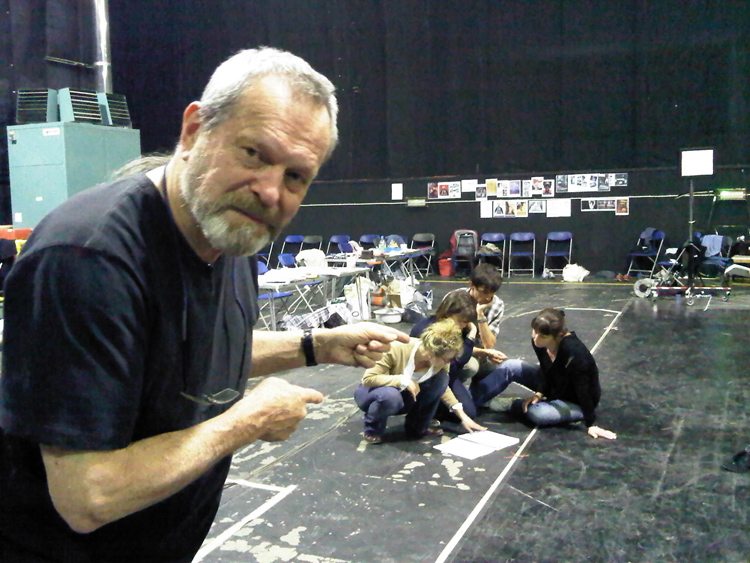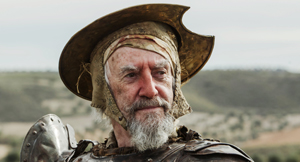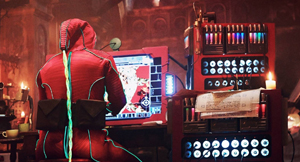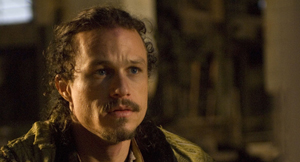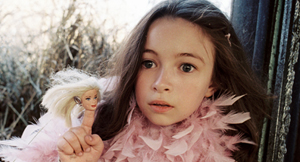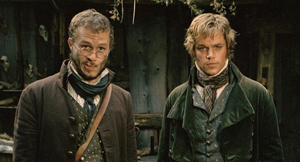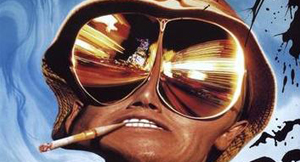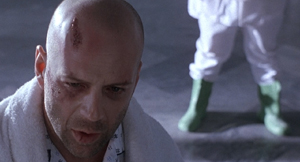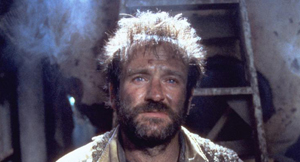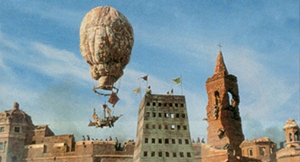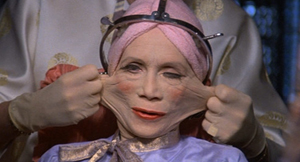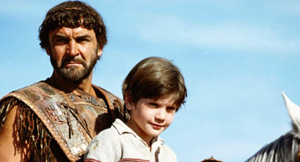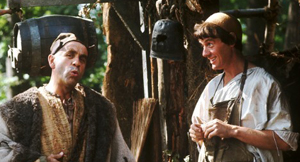Nicola Pecorini is the cinematographer for Tideland, which continues shooting in Canada as I write in November 2004. Working on this picture has given Pecorini a further chance to collaborate with Terry Gilliam, with whom he worked on Fear and Loathing in Las Vegas and the unfinished The Man Who Killed Don Quixote.
Clearly pleased with what has already been captured on film, Pecorini spent time with Dreams during his lunchbreak one day in the middle of the shooting schedule, in early November.
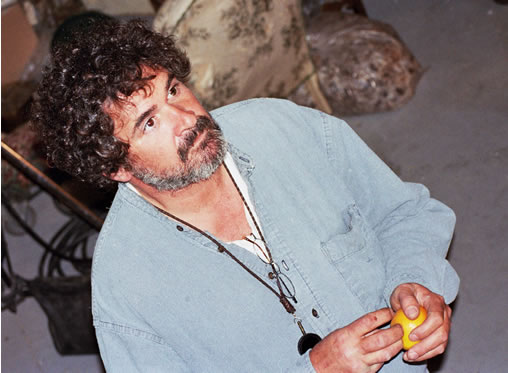 |
Nicola Pecorini on the set of Tideland |
Nicola, could you tell me how Tideland is going, from your perspective?
Very good, very, very good. I think we’re doing extraordinary story telling and imagery too. So I think it’s going great.
What attracted you to the project?
More than anything is Terry, that’s it. Either attracted or repulsed, that’s Terry! Tideland was a project that I had in my hands three years ago, the first draft I saw. And then it went in some sort of pre-production at some stage and then was put on the shelf because of many things. Then Terry came back out this spring, in the late spring, he was, “Oh yeah we’re going to make Tideland.” So after the experience last year on Grimms, it was great to work again with Terry.
On this project what are the main creative problems that you have faced that you’ve had to overcome?
One is budget – not in the sense of “Oh gosh, I can’t have my toys” and things like that. It’s a question of schedule. How many days you have to do it? How many tools? How many people you have to get you there to play with those tools? We have serious handicaps in terms of availability of people – both in terms of capable skilful technicians and availability of money to pay the eventual technician. For example we don’t have a rigging crew, we don’t have a striking crew. Therefore we’re always a bit lagging behind for necessity. It’s quite amazing to think you are in Canada in the G7 and things like that and you still have a six day turnaround for dailies. We had quicker turnaround in Kathmandu with Rome. Besides those things, in the end, there are inconveniences but they don’t really effect the making of the movie. It would be better to know before whether we can strike a set or not but there’s always problems when you make movies, especially in Terry’s movies! I mean, I can’t complain one bit.
The sets themselves – what problems are they causing?
Again for a lack of money and therefore a lack of preparation, and a lack of people who got here to make the job etc, they are not as functional as a day’s shoot could be. We had various situations in which we were almost jumping ahead of our department: getting into sets to light and to shoot sets that weren’t furnished yet and decorated yet. So those are the main problems. Other that that, the stages here are pretty good. I shot in worse places. And here we’re lucky enough that we have stages with no catwalk or whatever, but they are stages. We’ve been very lucky with the weather – when we were outside – so sincerely can’t complain much.
How do you make creative decisions with Terry?
In total chaos! By chance, by talking it out. We always talk a lot before production. And we start getting visual references and ideas, of which 90% of the time we dump on the day! But it’s all part of the process getting there. But the great thing about Terry is that he always allows the unexpected to intrude and mould what the movie is becoming. Therefore it’s great to have that freedom of mind that you often don’t find in the movies, and you can’t afford when you are doing a studio picture. But I would say that they are pretty much always kind of a very dis-organic decision but they become organic because of who we are. Because of the consistency of our approach to telling the story. But there isn’t a grand master plan behind it.
Do you choose the lens on the day?
Oh yeah, there isn’t much choice, its always wide, wide, wide! We just sent back the long lenses to save on the budget. I mean you always get the full set of lenses just because it’s wise to get it. But in the end we said we send them back. We save 150 bucks a week!
I understand you’ve had a long history with the Steadicam…
I started, I was lucky enough to discover the Steadicam when it was in the early stages of technical development of the machine itself, so I was involved in the designing of the new models, testing the prototypes and coming up with suggestions and things like that and from various areas in Europe there weren’t many reliable Steadicam operators – “reliable” in the sense that you could use what you shoot.
But I’d done it for 17 years. And I had the chance to work with a lot of people. It was a great, great experience and therefore every time I shoot a movie now, I try to use the Steadicam for what I learnt to use it, and I use it much more than you would use it normally.
You were talking last night about being in New York City in the late 70s. Could you tell me a bit about that?
I was in my early 20s and working as an assistant photographer for fashion photographers. It was fun, there was no AIDS, there were a lot of gay people and often I was the only not-gay. It was a lot of fun! I mean fashion photography is the most boring thing in the world – it’s always the same thing. I found myself there because the photographer I worked for was there. But I wouldn’t recommend it to anybody, unless you are really horny!
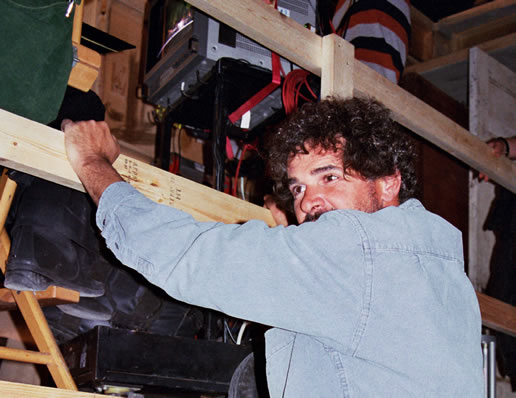
Do you have any subsequent projects in the pipeline?
No, because the scripts they send me really suck. And I’m not interested in making even big movies with shitty scripts. So for me the only thing is the story. I mean I’m in a lucky position somehow because I can make commercials; I can make a living without having to jump from one movie to the next, but really the scripts are more and more crap.
But the scripts that get to me are the scripts that have been green-lit, and they are about to be made! And you often wonder why, why would they bother with such pieces of crap. I keep receiving these police stories. On page 20 I give up because I don’t understand what they’re talking about, they talk in code: “I have to walk to the PBA office” and “Get me a C74 call”. What the fuck is all that about? It’s not real life for me so I don’t care.
And you wonder whether the scripts that haven’t been green lit are the good ones or they’re even worse.
Generally they are even worse! But there are some good ones hidden there somewhere. I see them because working with Terry for so many years and other people, friends, it’s so fucking hard to get anything off the ground, it’s unbelievable, it’s crazy.
You get years and years of pushing and by the time you get to production you’re exhausted, emptied and no energy left. I see it so many times happened. Directors who pitch for four years, they finally manage to make it to the set and: Blank! No Idea!
I’m sure there will be scripts come, hopefully Quixote. Talking of scripts, that’s the best script I ever read. Fantastic! But we’ll see. I’m still hopeful on that side. But who knows…?
Nicola maintains a website at www.nicolapecorini.com which includes several minutes of footage from “The Man Who Killed Don Quixote”, much of which was not included in the documentary film “Lost in La Mancha”.


